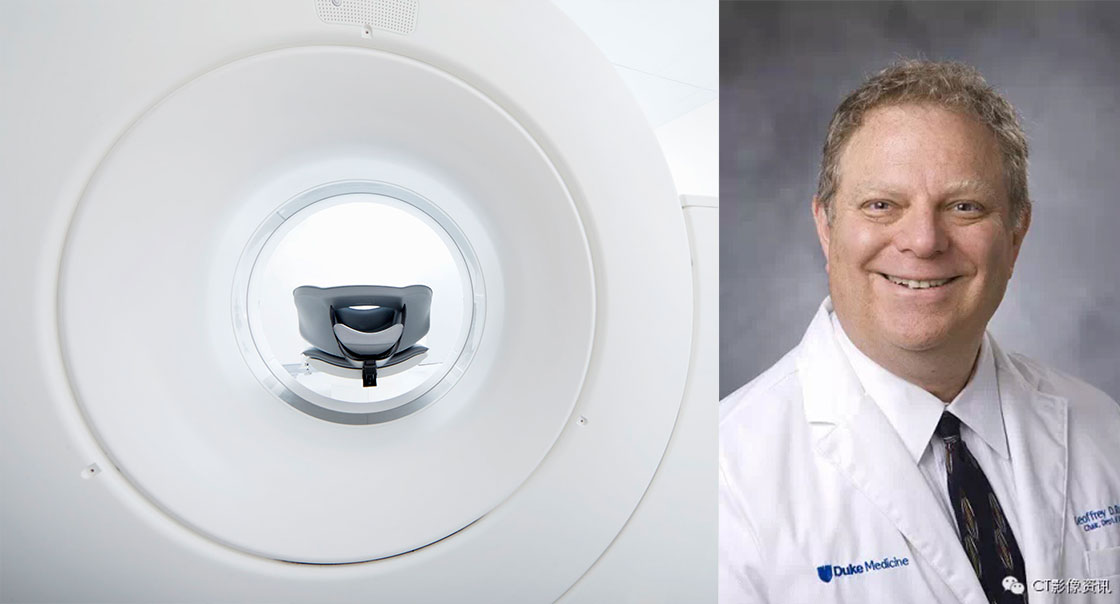
通過(guò)螺旋CT結(jié)合圖像容積處理,CT血管造影于20年前誕生了�����。由一系列的CT與圖像處理技術(shù)的創(chuàng)新所引發(fā)的,經(jīng)過(guò)之后的15年���,推翻傳統(tǒng)血管造影術(shù)——此前的70年一直是無(wú)可爭(zhēng)議的血管疾病的診斷參考標(biāo)準(zhǔn),CT血管造影術(shù)成為了診斷和顯示大多數(shù)心血管異常首選產(chǎn)品���。
Through a marriage of spiral computed tomography (CT) and graphical volumetric image processing, CT angiography was born 20 years ago. Fueled by a series of technical innovationsin CT and image processing, over the next 5–15 years, CT angiography toppledconventional angiography, the undisputed diagnostic reference standard forvascular disease for the prior 70 years, as the preferred modality for thediagnosis and characterization of most cardiovascular abnormalities.
本文回顧了CT血管造影術(shù)的演進(jìn)�,從其發(fā)展和早期挑戰(zhàn)到成熟產(chǎn)品�����,提供對(duì)于心血管疾病發(fā)現(xiàn)和治療獨(dú)有的視野��。所選的臨床挑戰(zhàn),包括急性主動(dòng)脈綜合征、周?chē)芗膊?��、主?dòng)脈支架術(shù)�、經(jīng)導(dǎo)管主動(dòng)脈瓣移植和評(píng)估及冠狀動(dòng)脈疾病��,這些是關(guān)于CT血管造影是如何改變我們對(duì)心血管疾病診斷和治療方法�����,并呈現(xiàn)了對(duì)比的例子���。
This review recounts the evolution of CT angiography from its development and early challenges to a maturingmodality that has provided unique insights into cardiovascular diseasecharacterization and management. Selected clinical challenges, which includeacute aortic syndromes, peripheral vascular disease, aortic stent-graft andtranscatheter aortic valve assessment, and coronary artery disease, arepresented as contrasting examples of how CT angiography is changing ourapproach to cardiovascular disease diagnosis and management.
最后�,結(jié)合最近推出了多能譜成像的功能���,組織灌注成像及由迭代重建致減少輻射劑量等探索���,思考對(duì)于CT血管造影術(shù)持續(xù)改進(jìn)與發(fā)展。
Finally, the recently introduced capabilities for multispectral imaging, tissue perfusion imaging, and radiationdose reduction through iterative reconstruction are explored with considerationtoward the continued refinement and advancement of CT angiography.
@RSNA��,2014
概要
受卓越的技術(shù)進(jìn)步所驅(qū)動(dòng)�,CTA(CT血管造影術(shù))已經(jīng)成為診斷并管理血管性疾病的主導(dǎo)影像方式。
Driven by profound technologic advances, CT angiography has emerged as the dominant imaging modality fordiagnosis and planning management of vascular diseases.
CTA提供了對(duì)急性主動(dòng)脈綜合征病理生理學(xué)和自然歷史的新見(jiàn)解��。
CT angiography has provided new insights into the pathophysiology and natural history of acute aorticsyndromes.
優(yōu)化的CTA技術(shù)可以綜合評(píng)價(jià)外周血管性疾病。
Optimized CT angiographic technique enables comprehensive assessment of peripheral arterial disease.
經(jīng)導(dǎo)管心血管治療的進(jìn)步�����,包括主動(dòng)脈支架與主動(dòng)脈瓣膜植入技術(shù)�,與CTA所提供的新見(jiàn)解是相關(guān)的。
The advancement of trans catheter cardiovascular therapies, including aortic stent-graft deployment and aorticvalve implantation, are linked to insights provided by CT angiography.
CT技術(shù)的創(chuàng)新提供了前所未有的機(jī)遇�����,進(jìn)一步增強(qiáng)了CTA的安全性和臨床價(jià)值�����。
Innovations in CT technology are providing unprecedented opportunities to further enhance the safety andclinical value of CT angiography.
過(guò)去的20年��,血管性疾病的診斷與定性方面發(fā)生巨大的轉(zhuǎn)變��。隨著CTA(CT血管造影)�����、對(duì)比劑增強(qiáng)法MRA(磁共振血管造影)和主動(dòng)脈瘤腔內(nèi)支架修復(fù)等技術(shù)的引入�,20世紀(jì)90年代已成為血管性疾病診斷與治療的黃金時(shí)期�����。
The past 20 years have witnessed a remarkable transformation in the diagnosis and characterization of vascular disease. The1990s were a particularly golden period in vascular diagnosis and therapy withthe introduction of computed tomographic(CT) angiography, contrastmaterial–enhanced magnetic resonance (MR) angiography, and endovascular repairof aortic aneurysms using stent-grafts.
1990年代早期,幾乎每一例準(zhǔn)備接受血管手術(shù)���、需要確診肺栓塞����、疑似創(chuàng)傷性主動(dòng)脈損傷����、顱內(nèi)動(dòng)脈瘤或者腎性高血壓的病人,都要進(jìn)行傳統(tǒng)的診斷性血管造影檢查�,該項(xiàng)技術(shù)誕生于1924年(1),并在1953年(2)引入了Seldinger穿刺導(dǎo)絲引導(dǎo)技術(shù)之后����,被大幅改良并沿用至今。
In the early 1990s nearly every patient preparing to undergo vascular surgery, requiring confirmation of pulmonary embolism, orsuspected of having traumatic aortic injury, intracranial aneurysm, orrenovascular hypertension underwent conventional diagnostic angiography, atechnique that was born in 1924 (1) and substantially refined topresent-day technique with the introduction of the Seldinger guidewire in 1953(2).
結(jié)合注射器�、膠片(自動(dòng))替換盒、透視�����、平片、減影技術(shù)的穩(wěn)步提高�����,直接動(dòng)脈造影術(shù)已經(jīng)發(fā)展為各種血管性疾病診斷與定性的參考標(biāo)準(zhǔn)���。這項(xiàng)技術(shù)的優(yōu)勢(shì)在于具有較高的空間分辨率�����,并且可以同時(shí)進(jìn)行介入診斷與治療���。
Combined with steady improvements in injectors, film changers, and fluoroscopic, radiographic, and subtraction techniques, directarteriography evolved as the reference standard for the diagnosis andcharacterization of all manner of vascular disease. Its strengths were a highspatial resolution and an opportunity for diagnosis and therapeuticintervention during a single session.
它的局限性包括費(fèi)用、不適和侵入性檢查所帶來(lái)的風(fēng)險(xiǎn)�����,尤其是無(wú)需同時(shí)進(jìn)行干預(yù)治療的時(shí)候����;不能顯示血管壁、血管外周組織和終末器官實(shí)質(zhì)的情況����;基于投影采集的性質(zhì)導(dǎo)致三維(3D)辨別能力差;必須多次注射對(duì)比劑和反復(fù)曝光來(lái)顯示空間相互關(guān)系���;選擇性的動(dòng)脈注射對(duì)比劑導(dǎo)致遠(yuǎn)端管腔顯示受限���。
Its limitations were the cost, discomfort, and risks of an invasive procedure, particularly when concurrent intervention was notindicated; inability to demonstrate the vessel wall, perivascular tis- sue, andend-organ parenchyma; poor three-dimensional (3D) spatial discrimination owingto the projectional nature of the acquisition; necessity for multiple contrastmaterial injections and repeated doses of ionizing radiation to characterizespatial relationships; and downstream luminal opacification limited byselective arterial injection of contrast material.
MRA(磁共振血管造影術(shù))1986年(3、4)首次報(bào)道�,這是一個(gè)令人興奮的新技術(shù),它依賴(lài)于流動(dòng)-增強(qiáng)模式���,待技術(shù)進(jìn)一步改進(jìn)�����,它將成為血管性疾病診斷的一種主流模式�。
MR angiography, first reported in1986 (3,4) was an exciting new technique that was dependent on flow-related enhancement, awaiting further technical improvements that wouldmake it a main- stream diagnostic angiographic modality.
同時(shí)�����,常規(guī)CT采集10mm層厚標(biāo)準(zhǔn)(5)�,已經(jīng)被視為一項(xiàng)趨于成熟的技術(shù),正廣泛應(yīng)用于醫(yī)療診斷中�����,但是對(duì)血管性疾病評(píng)價(jià)有限,僅可以通過(guò)跟蹤腹主動(dòng)脈瘤的橫斷面圖像評(píng)估主動(dòng)脈破裂的風(fēng)險(xiǎn)�。
At the same time, conventional CT, acquired with 10 mm-thick sections that were standard for the day (5), was viewed as a maturing technology, having made tremendous inroads into abroad spectrum of medical diagnoses, but was limited for the assessment ofvascular disease with only one mainstream application, assessing aortic rupturerisk by tracking the transverse dimension of abdominal aortic aneurysms.



